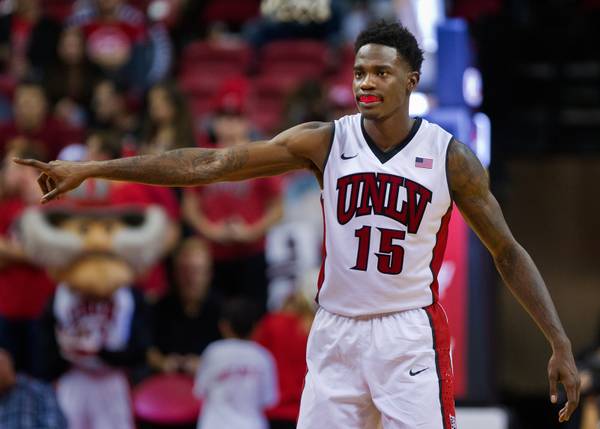Dwayne Morgan is not a perfect basketball player. His shot selection still needs some work, he commits too many turnovers, and he’s still way too foul-prone, even in his third season. Coach Marvin Menzies will freely admit all that.
But even with those faults, Menzies is more than happy to have Morgan on the roster and to pencil him into the lineup as often as he can, for one simple reason: When Morgan plays, he makes the Rebels better. By a lot.
Through six games, Morgan’s impact on UNLV has been tremendously positive, though it might not be reflected by traditional statistics. Morgan is averaging just 8.0 points, 6.0 rebounds and 1.4 blocks in 20.6 minutes per game — not superstar numbers, by any means — but the Rebels have played their best basketball with Morgan on the floor.
Related content
Morgan missed the opening game of the season due to a hip injury, but in the five games since, he’s played a total of 104 minutes. During that time with Morgan on the court, UNLV has outscored its opponents, 191-134. That’s a raw plus/minus of +57, and it works out to a rate of +21.8 per 40 minutes.
For context, in the 136 minutes without Morgan on the floor, UNLV has basically broken even, outscoring its opponents, 268-267. Morgan has taken a decent team and turned it into a powerhouse during his minutes on the court.
He’s done it mostly by playing spectacular defense. Christian Jones’ injury, along with the Rebels’ thin depth chart in the frontcourt, has forced the 6-foot-8 Morgan to play center, and he’s done an outstanding job in the middle despite being undersized for the position. Opposing teams are shooting 42.1 percent against UNLV without Morgan on the floor (69-of-164), but that drops to a ridiculous 29.6 percent (42-of-142) when Morgan is patrolling the paint.
Part of it is Morgan helping the Rebels play good team defense, and part of it is Morgan simply shutting down the players he’s tasked with defending. According to Synergy Sports data, opponents are shooting 27.3 percent and scoring 0.5 points per possession when guarded by Morgan this season.
When asked how Morgan has been able to excel on the defensive end, Menzies said Morgan makes up for his lack of size by playing to his strengths.
“His athleticism, obviously, and his energy,” Menzies said. “It’s very rare that you get a 5-man that can step out and do the things that he can do.”
That’s why it’s so important for Morgan to stay on the floor. Menzies would love to run him out there for 30 minutes every night, but Morgan finds his playing time limited by foul trouble more often than not. He’s averaging 7.0 fouls per 40 minutes (last year he was at 7.1 per 40), and he had to play the final nine minutes of Saturday’s win over Western Kentucky while saddled with four fouls.
Menzies said developing Morgan’s defense while limiting his fouls is a work in progress.
“He had some challenges with foul trouble last year,” Menzies said, “so we’re teaching him some technical aspects that allow him to put himself in a better situation. Working earlier in the shot clock to get himself in better position, so you do your work early [in the possession] and then you’re not working from behind to grab or do things with your upper body. Just little technical things. He’s learning how to not foul. He’s learning how to play with fouls. All of that is a process for him and he’s embracing it.”
Morgan’s foul trouble limited him to 20 minutes against Western Kentucky and forced Menzies to play freshman center Djordjije Sljivancanin for eight minutes. UNLV outscored WKU by 20 points with Morgan on the floor, but the Rebels were outscored by 14 with Sljivancanin playing. UNLV ended up pulling away late to win by 10, but had Morgan stayed out of foul trouble and given the team eight more minutes (allowing Menzies to keep Sljivancanin on the bench), the result may have been a blowout victory.
Menzies said Morgan is aware of how important he is to the team and how vital it is to reduce his fouls and maximize his court time.
“He knows,” Menzies said. “He’s a smart kid. What makes him good is what gets him in trouble with all that energy. But I’d rather have somebody that I have to reel in than somebody that I have to push. A guy like that is much easier to coach than someone who doesn’t have the energy or doesn’t play hard. That’s why he’s a crowd favorite — he brings it. You’ve just got to get him to understand how to manage it.”
If Morgan can get his fouling under control, he could be the difference between a losing season and a surprisingly good campaign. The sample size is small, but he’s defending at an elite level and rebounding better than he ever has (he’s currently sporting a defensive rebounding rate of 22.1 percent, the highest of his career and tops on the Rebels), and he appears to have assumed a leadership role in his third year.
Menzies wants that player on the floor as much as possible.
“He’s a great kid,” Menzies said. “I love coaching him. The biggest advantage is that he’s all the way in. He’s bought in. And so when you have a guy like that, it doesn’t matter what his physical tools are, you get him to play to his strengths and demand a lot from him.”
So far this season, Morgan has delivered.


Join the Discussion:
Check this out for a full explanation of our conversion to the LiveFyre commenting system and instructions on how to sign up for an account.
Full comments policy